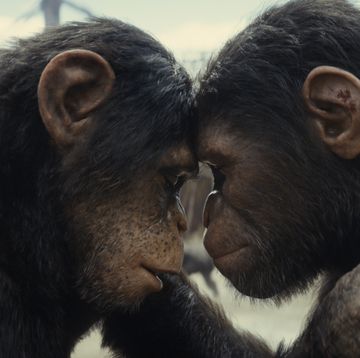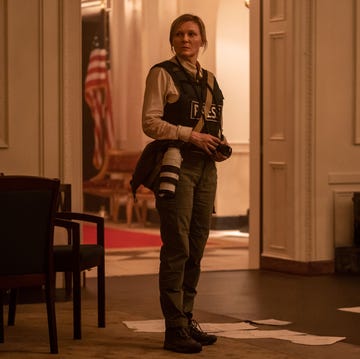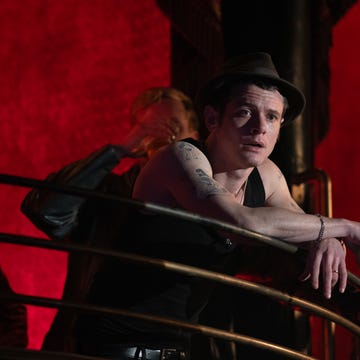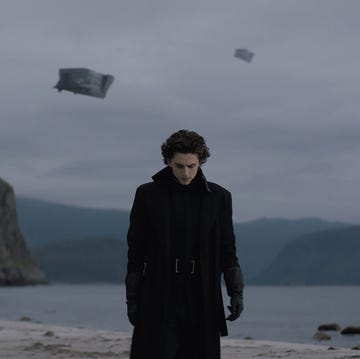So you've seen the film, bid on Brad Pitt's retro Champion t-shirt and put the downpayment on the white 1966 Cadillac DeVille to cruise down Sunset. Still, you might be looking for more to fill the Once Upon a Time in... Hollywood-shaped hole in your life, so grab your blender of frozen margaritas and settle in.
In his ninth film Tarantino "block by block" recreates 1969s Hollywood, and the drive-in cinemas and neon boulevards of the era. As such, the film is packed with references to movies of the time, from posters of the 1968 adaption of Romeo and Juliet, to mentions of real TV series Lancer which Rick Dalton appears on.
A great place to start exploring these influences would be Tarantino's list of the 10 movies he recommends watching before seeing the flick, but it's just as interesting to pour over afterwards. The list includes Sharon Tate's last film The Wrecking Crew, which Margot Robbie's iteration of the actress goes to see in Once Upon a Time. There's also several of the kind of Westerns Rick would have killed for a part in, such as Arizona Raiders and Gunman's Walk.
There's also the online magazine which was created to accompany the release of the film, which includes an editor's letter from Tarantino and a big interview with Bounty Law star Dalton. There's also lots of the fun paraphernalia from the world of Rick and Cliff, like adverts for the Red Apple cigarettes that appear in the mid-credits scene.
Outside of Tarantino's homework list there are many, many films referenced in Once Upon a Time to catch up on. Roman Polanski's award-winning Rosemary's Baby is the film which, in Tarantino's fictional world, was made right before Polanski and Tate moved in next-door to Rick Dalton.
The Great Escape also appears, with Tarantino playfully swapping Rick Dalton into a famous scene instead of Steve McQueen. If it's one of those seminal films you fib about having seen to everyone, it's a great example of the kind of classic film that Rick imagines himself in touching distance of.
Spaghetti Westerns have influenced several of Tarantino's films, such as the link between Sergio Corbucci's Django to the director's character of the same name. He often borrows from their cinematic style, using dramatic close-ups of eyes and guns while operatic music plays over the drama. Others which the auteur has recommended in the past include The Good, the Bad, and the Ugly and For a Few Dollars More, both from Italian director Sergio Leone.
Music is such an essential part of the film, with snippets of retro radio adverts for Tanya Tanning Butter or Numero Uno Cologne transporting you back to 1969. The official soundtrack to the film has been released by Sony Records, featuring adverts jingling before the tracks come in as though you're really tuned into the radio.
Highlights include classics such as Simon & Garfunkel's Mrs Robinson, or Neil Diamonds' song from the film trailer, Brother Love's Travelling Salvation Show. Elsewhere there's groovy rock from the likes of The Box Tops or The Detroit Wheels, and the fairytale-like final track, which is also used in Paul Newman's Western film The Life and Times of Judge Roy Bean.
Several soundtrack selections have hidden significance, like the slowed-down cover version of The Mamas & the Papas' California Dreamin', the singer of which was a friend of Tate and Polanski's. At one point during the film Tate dances to a record in her bedroom by Paul Revere & The Raiders. The song is significant as singer Mark Lindsay once lived at 10050 Cielo Drive, and claims that he met Manson at a party there.
Though Tarantino was at pains to say his film was about Los Angeles in the summer of 1969, not Charles Manson, there's no denying that the Manson "family" are the menacing backdrop to the fictional action, as well as providing the controversial end to the film.
So much pop-culture has attempted to demystify the infamous cult over the last 50 years, some with better results than others. For those wanting to know more about Charles Manson himself, Jeff Guinn’s 2013 book, Manson: The Life and Times of Charles Manson, conducts interviews with Manson's sister and cousin, as well as childhood friends, cellmates, and some members of the Manson "family" to provide a comprehensive picture of the killer. Guinn also delves into Manson's ambitions of musical success and how the murders were part of his quest for infamy, arguing that he represented "the dark side of a generation".
There's also Helter Skelter from Vincent Bugliosi, the prosecutor who worked the case at the time. The number 1 selling true crime book of all time, Helter Skelter drills down into the details of the night of Sharon Tate's murder and the subsequent trial.
It's an account of the Manson "family" from someone who poured over details in order to put them away, and as such it recounts details about forensic evidence and the battles Bugliosi faced with the LAPD. There's also a TV mini-series adaptation of the book with the same name, which has Steve Railsback playing Manson.
Also interesting is The Family, published at the time of the case by Ed Sanders, a poet and journalist working in Los Angeles in the Sixties. Sanders speaks to high profile members of the cult to understand what drew them to Manson's ideas, and offers the perspective of someone that was part of the scene at the time.
In fiction, Emma Cline's best-selling novel The Girls is inspired by the Manson "family", and 2011 film Martha Marcy May Marlene is an interesting look at cults and how charismatic leaders manipulate their following.
One of the most comprehensive and interesting podcasts on the matter is Karina Longworth's Charles Manson's Hollywood. The two part instalment is part of her series You Must Remember, which explores the forgotten histories of Hollywood's first century.
One writer who captured the fatalistic mood of that night completely was Joan Didion, who reckoned with the sense of innocence lost in the titular essay of her 1979 collection, The White Album:
"Many people I know in Los Angeles believe that the Sixties ended abruptly on August 9, 1969, at the exact moment when word of the murders on Cielo Drive traveled like brushfire through the community, and in a sense this is true. The tension broke that day. The paranoia was fulfilled."
Like this article? Sign up to our newsletter to get more articles like this delivered straight to your inbox
















